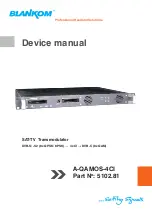
3
A-QAMOS-4CI
Part N
o
: 5102.81
SAT-TV Transmodulator
DVB-S/ -S2 (8x QPSK/ 8PSK)
→
4x CI
→
DVB-C (8x QAM)
A
LINE
1. Safety and operating instructions
When assembling, starting-up and adjusting the devices, it is necessary to consider the system specific references in
the instruction manual.
The devices may only be installed and started up by authorized technical personnel.
When assembling the devices into the receiving points, the adherence of the EMC regulations is to be ensured.
The assembly and wiring have to be done without voltage.
With all work the defaults of the DIN EN 50083 have to be considered. It is especially important to follow
DIN EN 60728-11[2].
If installed in mounting cabinets a adequate heat circulation must be guaranteed. The mounting in closed cabinets with-
out air sufficient flow is
not allowed
.
The devices come under protection classification I. It is absolutely necessary, therefore, to insert the mains plug into a
socket with protective contact.
2. Device variants
A-QAMOS-4CI
5102.81 DVB-S/ -S2 (8x QPSK/ 8PSK)
→
4x CI
→
DVB-C (8x QAM)
3. Softwareoptionen
CKB 205
5100.55 activation advanced NIT processing
CKB 214
5100.64 activation media player/ SD card
4. General
The SAT-TV Transmodulator A-QAMOS-4CI is a device of the head end system A-LINE, which is conceived as a complete system
for big and middle sized networks.
The A-QAMOS-4CI converts digital satellite signals into QAM signals to transmit it in cable networks. In this case, up to 8 QAM
channels from the available satellite IF signals are generated, which are attached via two inputs. Two Common Interface slots enab-
les the use of up to 4 CA modules for the reception of scrambled satellite signals/ programms. In particular, the internal processing
allows the output of DVB signals in full HD resolution.
5. Functional description
The satellite IF signal is fed through 2 inputs or a loop-through input by means of a switching matrix to 8 DVB-S/ S2 input parts
and their QPSK/ 8PSK demodulators. The resulting 8 transport streams are fed a high-performance FPGA. The transport stream
processing or filtering, the QAM modulation and the freely adjustable up-converting in the cable network range (45 ... 862 MHz)
take place in the FPGA. Two Common Interface slots enables the use of 4 CA modules, which are cascadable, for the reception of
scrambled satellite signals/ programms.
The eightfold modulator is adjacent channel compatible. A highly-clocked digital to analogue converter (DAC) is responsible for the
spectrally pure output of the cable signal. After amplification and sum level adjustment, the cable signal is coupled through a direc-
tional coupler to the output jacks.
WEEE-Reg.-Nr. DE 50389067































